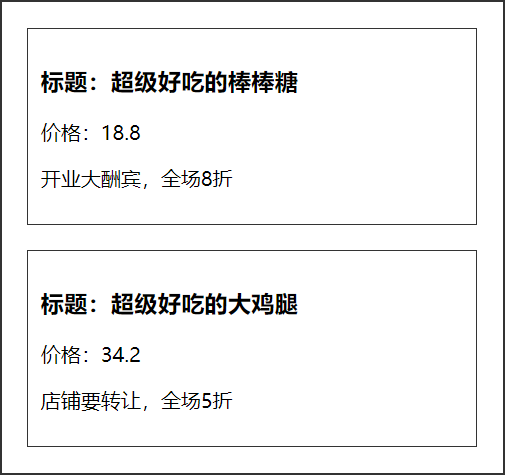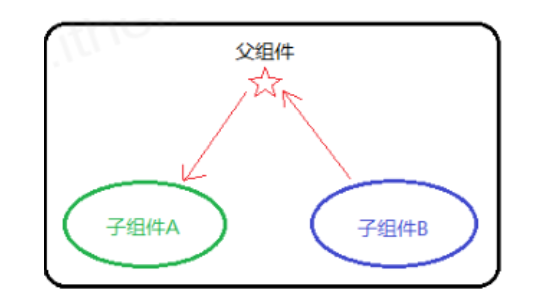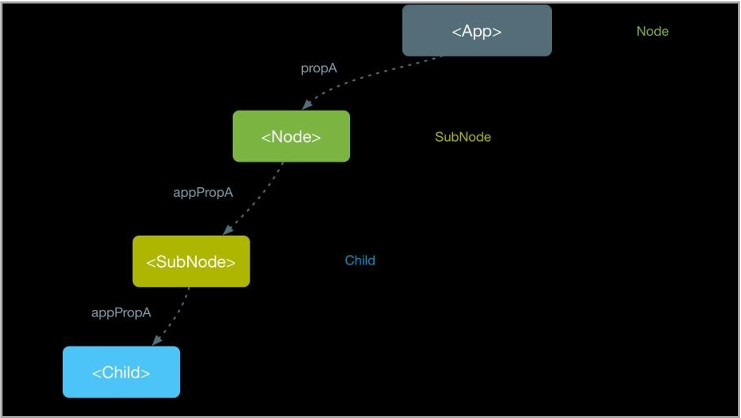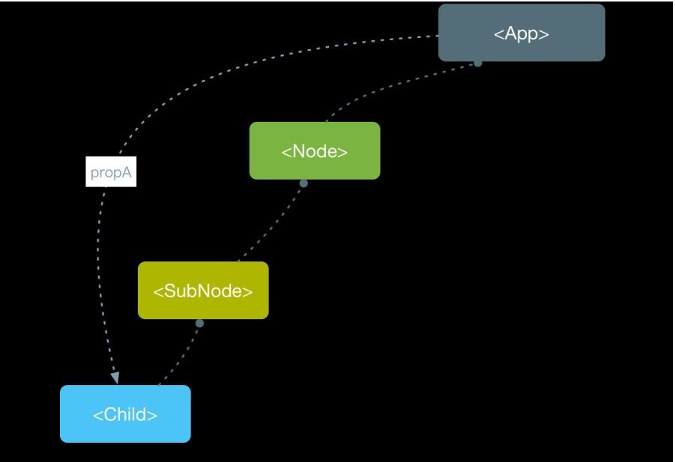组件通讯介绍
目标:了解为什么需要组件通讯?
内容:
_组件_是独立且封闭的单元,默认情况下,只能使用组件自己的数据。
在组件化过程中,我们将一个完整的功能拆分成多个组件,以更好的完成整个应用的功能。
而在这个过程中,多个组件之间不可避免的要共享某些数据
为了实现这些功能,就需要
打破组件的独立封闭性,让其与外界沟通。这个过程就是组件通讯。组件通信常见的方式有:父传子、子传父、兄弟相传、跨组件通信等。
总结
- 组件中的状态是私有的,也就是说,组件的状态只能在组件内部使用,无法直接在组件外使用
props基本使用
**目标:**能够使用组件的props实现传递数据和接收数据
内容:
- prop: property 属性的简写
- 使用场景:组件接收外部数据时
- 作用:接收(其他组件)传递给当前组件的数据
- 如何传递?给组件标签添加属性,就表示给组件传递数据
- 如何接收?函数组件通过参数
props接收数据,类组件通过this.props
核心代码:
- 函数组件获取props
js
// 接收数据:
// props 的值就是:{ name: 'jack', age: 19 }
function Hello(props) {
return (
<div>接收到数据:{props.name}</div>
)
}
// 传递数据:
// 可以把传递数据理解为调用函数 Hello,即:Hello({ name: 'jack', age: 19 })
<Hello name="jack" age={19} />- 类组件获取props
js
// 接收数据:
// class 组件需要通过 this.props 来获取
class Hello extends Component {
render() {
return (
<div>接收到的数据:{this.props.age}</div>
)
}
}
// 传递数据:
<Hello name='jack' age={19} />props的注意点
目标: 了解props的特点,知道什么是单向数据流
内容:
- props 是只读对象,只能读取对象中的属性,无法修改
单向数据流,也叫做:自上而下的数据流- 表示:父组件中的数据可以通过 props 传递给子组件,并且,当父组件中的数据更新时,子组件就会自动接收到最新的数据
- 父组件的数据更新会流动到子组件,不能反过来,子组件直接去修改父组件的数据
- 类比:就像瀑布的水一样只能从上往下流动,并且,当上游的水变浑浊,下游的水也会受到影响
- 可以传递任意数据(数字 字符串 布尔类型 数组 对象 函数 jsx)
- 如果是字符串类型,可以直接传递
- 如果是其他类型,需要在
{}中提供
- 使用类组件时,如果写了构造函数,应该在 constructor 中接收 props,并将 props 传递给 super,否则无法在构造函数中使用 this.props。
组件通讯-父传子
目标:将父组件的数据,传递给子组件
内容:
- 父组件提供要传递的state数据
- 给子组件标签添加属性,值为 state 中的数据
- 子组件中通过 props 接收父组件中传递的数据
核心代码
父组件提供数据并且传递给子组件
js
class Parent extends React.Component {
state = { money: 10000 }
render() {
return (
<div>
传递数据给子组件:<Child name={this.state.money} />
</div>
)
}
}子组件接收数据
js
function Child(props) {
return <div>子组件接收到数据:{props.money}</div>
}组件通讯-子传父练习
目标

准备父组件
数据、结构、样式
jsx
//components/Parent/index.js
import React, { Component } from 'react'
import Child from '../Child'
import './index.css'
class Parent extends Component {
state = {
list: [
{
id: 1,
name: '超级好吃的棒棒糖',
price: 18.8,
info: '开业大酬宾,全场8折',
},
{
id: 2,
name: '超级好吃的大鸡腿',
price: 34.2,
info: '开业大酬宾,全场8折',
},
{
id: 3,
name: '超级无敌的冰激凌',
price: 14.2,
info: '开业大酬宾,全场8折',
},
],
}
render() {
return (
<div className='parent'>
<Child></Child>
<Child></Child>
</div>
)
}
}
export default Parent
//components/Parent/index.css
.parent {
width: 400px;
margin: 60px auto 0;
border: 2px solid #333;
}准备子组件
结构、样式
jsx
//components/Child/index.js
import React, { Component } from 'react'
import './index.css'
export default class Child extends Component {
render() {
return (
<div className='child'>
<h3 className='title'>标题:超级好吃的棒棒糖</h3>
<p className='price'>价格:18.8</p>
<p className='product'>开业大酬宾,全场8折</p>
</div>
)
}
}
//components/Child/index.css
.child {
border: 1px solid #333;
margin: 20px;
padding: 10px;
}传递数据
jsx
//components/Parent/index.js
import React, { Component } from 'react'
import Child from '../Child'
import './index.css'
class Parent extends Component {
{/* ... */}
render() {
return (
<div className='parent'>
{this.state.list.map((item) => (
<Child key={item.id} {...item} />
))}
</div>
)
}
}
//components/Child/index.js
import React, { Component } from 'react'
import './index.css'
export default class Child extends Component {
render() {
const { name, price, info } = this.props
return (
<div className='child'>
<h3 className='title'>标题:{name}</h3>
<p className='price'>价格:{price}</p>
<p className='info'>{info}</p>
</div>
)
}
}完整代码
jsx
//components/Parent/index.js
import React, { Component } from 'react'
import Child from '../Child'
import './index.css'
class Parent extends Component {
state = {
list: [
{
id: 1,
name: '超级好吃的棒棒糖',
price: 18.8,
info: '开业大酬宾,全场8折',
},
{
id: 2,
name: '超级好吃的大鸡腿',
price: 34.2,
info: '开业大酬宾,全场8折',
},
{
id: 3,
name: '超级无敌的冰激凌',
price: 14.2,
info: '开业大酬宾,全场8折',
},
],
}
render() {
return (
<div className='parent'>
{this.state.list.map((item) => (
<Child key={item.id} {...item} />
))}
</div>
)
}
}
export default Parent
//components/Child/index.js
import React, { Component } from 'react'
import './index.css'
export default class Child extends Component {
render() {
const { name, price, info } = this.props
return (
<div className='child'>
<h3 className='title'>标题:{name}</h3>
<p className='price'>价格:{price}</p>
<p className='info'>{info}</p>
</div>
)
}
}组件通讯-子传父
目标:能够将子组件的数据传递给父组件
内容:
思路:利用回调函数,父组件提供回调,子组件调用,将要传递的数据作为回调函数的参数。
- 父组件提供一个回调函数(用于接收数据)(箭头函数)
- 将该函数作为属性的值,传递给子组件
- 子组件通过 props 调用回调函数
- 将子组件的数据作为参数传递给回调函数
核心代码:
父组件提供函数并且传递给子组件
js
class Parent extends React.Component {
// 注意这个函数要是箭头函数,保证 this 指向自己的组件实例
getChildMsg = (msg) => {
console.log('接收到子组件数据', msg)
}
render() {
return (
<div>
/* #1 父组件提供回调函数 */
子组件:<Child getMsg={this.getChildMsg} />
</div>
)
}
}子组件接收函数并且调用
js
class Child extends React.Component {
state = { childMsg: 'React' }
handleClick = () => {
this.props.getMsg(this.state.childMsg)
}
return (
<button onClick={this.handleClick}>点我,给父组件传递数据</button>
)
}总结:
- 子组件如何给父组件传递数据?
- 父组件如何接收子组件传递的数据?
- 父组件的数据更新后,子组件会不会自动更新?
子传父的数据流向

组件通讯-子传父练习
目标:

组件通讯-兄弟组件
**目标:**能够理解什么是状态提升,并实现兄弟组件之间的组件通讯
内容:
- 将共享状态提升到最近的公共父组件中,由公共父组件管理这个状态
- 思想:状态提升
- 公共父组件职责:
- 提供共享状态
- 提供操作共享状态的方法
- 要通讯的子组件只需通过 props 接收状态或操作状态的方法
状态提升前

状态提升之后

核心代码
index.js
jsx
import React, { Component } from 'react'
import ReactDOM from 'react-dom'
import Jack from './Jack'
import Rose from './Rose'
class App extends Component {
// 1. 状态提升到父组件
state = {
msg: '',
}
render() {
return (
<div>
<h1>我是App组件</h1>
<Jack say={this.changeMsg}></Jack>
{/* 2. 把状态给子组件显示 */}
<Rose msg={this.state.msg}></Rose>
</div>
)
}
changeMsg = (msg) => {
this.setState({
msg,
})
}
}
// 渲染组件
ReactDOM.render(<App />, document.getElementById('root'))jack.js
jsx
import React, { Component } from 'react'
export default class Jack extends Component {
render() {
return (
<div>
<h3>我是Jack组件</h3>
<button onClick={this.say}>说</button>
</div>
)
}
say = () => {
this.props.say('you jump i look')
}
}rose.js
jsx
import React, { Component } from 'react'
export default class Rose extends Component {
render() {
return (
<div>
<h3>我是Rose组件-{this.props.msg}</h3>
</div>
)
}
}组件通讯 - Context
**目标:**通过context实现跨级组件通讯
内容
组件之间的层级关系,除了以上两种常见的情况外,还有一种不太常见的情况,那就是:远房亲戚关系(也就是两个组件之间间隔较远)


实现方式:使用 Context 来实现跨组件传递数据
Context: 上下文, 可以理解成一个范围,只要在这个范围内,就可以直接跨组件进行通讯。
步骤
- 祖先组件通过
React.createContext()创建 Context 并导出。 - 祖先组件通过
<Context.Provider>配合 value 属性提供数据。 - 后代组件通过
<Context.Consumer>配合函数获取数据。 - 优化:提取
React.createContext()到单独的文件里面。
代码
jsx
//App.jsx
import React, { Component, createContext } from 'react'
import A from './A'
export const context = createContext()
export default class App extends Component {
state = {
money: 8888,
}
changeMoney = (n) => {
this.setState({
money: this.state.money + n,
})
}
render() {
return (
<context.Provider
value={{
money: this.state.money,
changeMoney: this.changeMoney,
}}
>
App
<hr />
<A />
</context.Provider>
)
}
}
//A.jsx
import React, { Component } from 'react'
import B from './B'
export default class A extends Component {
render() {
return (
<div>
A
<hr />
<B />
</div>
)
}
}
//B.jsx
import React, { Component } from 'react'
import { context } from './App'
export default class B extends Component {
render() {
return (
<context.Consumer>
{(value) => {
return (
<div>
<h1>{value.money}</h1>
<button onClick={() => value.changeMoney(8)}>changeMoney</button>
</div>
)
}}
</context.Consumer>
)
}
}另一种获取数据的方式
jsx
import React, { Component } from 'react'
import { Context } from '../../context'
export default class B extends Component {
// 声明一个静态属性 contextType 等于 Context 对象
static contextType = Context
// 然后就可以通过 this.context 拿到传递过来的数据啦
render() {
return <div>B {this.context.age}</div>
}
}指定默认值
注意默认值生效的条件:并不是不传递 value,而是没有找到包裹 Context.Provider 的祖先元素
jsx
import React from 'react'
export const Context = React.createContext({
age: 88,
})